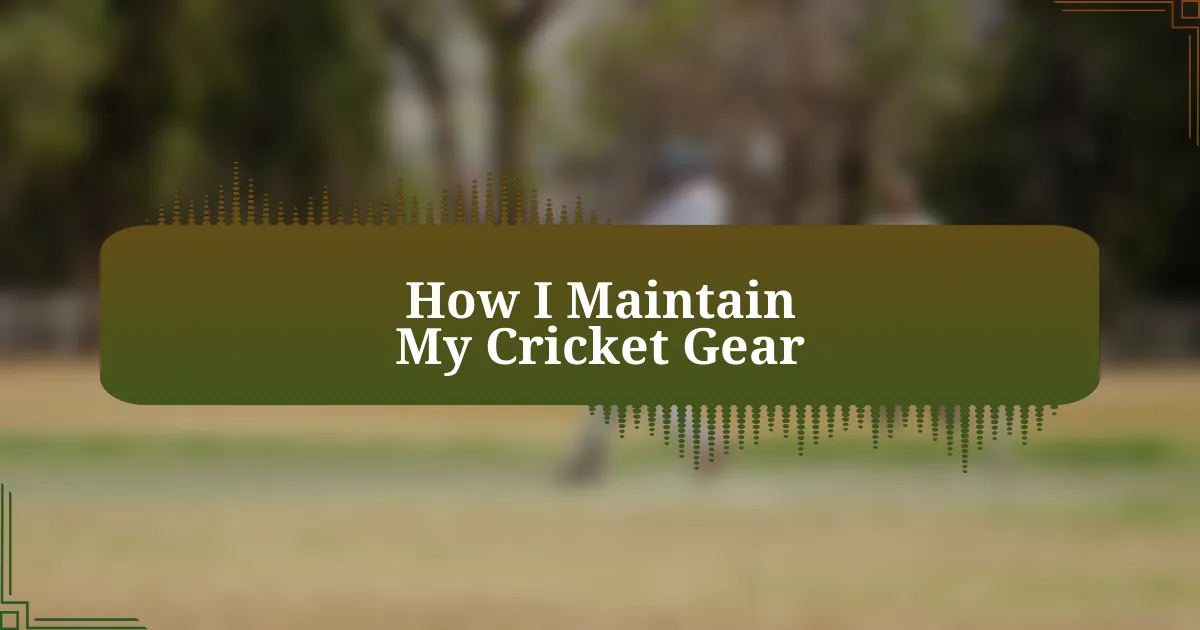Key takeaways:
- Proper maintenance of cricket gear enhances performance and extends the lifespan of equipment.
- Regular cleaning, inspections, and conditioning (e.g., using linseed oil) are essential to avoid costly damages and ensure safety.
- Storing gear in a cool, dry place prevents mold and odors, safeguarding its condition.
- Recognizing signs of wear and replacing gear when necessary is crucial for performance and safety on the field.
Author: Evelyn Harper
Bio: Evelyn Harper is an award-winning author known for her evocative storytelling and rich character development. With a background in psychology, she weaves intricate narratives that explore the complexities of human relationships. Her debut novel, “Whispers in the Wind,” received critical acclaim and established her as a fresh voice in contemporary fiction. A graduate of the Iowa Writers’ Workshop, Evelyn resides in Portland, Oregon, where she continues to write and inspire aspiring authors through workshops and mentorship. When not immersed in her writing, she enjoys hiking the Pacific Northwest trails and sipping coffee at local cafes.
Understanding cricket gear maintenance
Understanding cricket gear maintenance goes beyond just cleaning; it’s about nurturing your equipment to prolong its life and performance. When I first started playing, I overlooked the importance of regular upkeep. I vividly remember the disappointment of a torn cricket glove due to neglect, which made me realize that a little care can go a long way.
I often think about how much money I’ve invested in my gear, and it just feels wrong to let that go to waste. After each match, I take a moment to inspect my pads and gloves, checking for any wear and tear. This habit not only prevents issues but also helps me build a connection with my gear, almost like nurturing a teammate.
Have you ever had a favorite bat lose its zing? For me, it was heart-wrenching when I noticed my cherished bat wasn’t performing as it used to. Since then, I’ve learned to apply linseed oil regularly, keeping the wood healthy and vibrant. It’s a simple step, but it transforms a good bat into a great one, and trust me, it’s worth the effort.
Importance of maintaining cricket gear
Maintaining cricket gear is crucial for not only its longevity but also for enhancing performance on the field. I’ll never forget the time I rushed into a match with worn-out spikes. As the game progressed, I struggled for footing—talk about a frustrating experience! That day taught me that properly maintained gear can drastically influence both performance and safety.
When I take the time to care for my equipment, I feel a real sense of pride and ownership. It’s comforting to know that my bat is oiled and my gloves are clean and intact. This attention to detail doesn’t just protect my investment; it builds my confidence. After all, how can I focus on my swing when I’m worried about my gear letting me down?
Lastly, I think about the camaraderie among teammates. We share gear sometimes, and I want them to experience my gear at its best. Keeping everything in good shape is my way of showing respect not only for my equipment but for my teammates as well. Isn’t that an important aspect of being part of a team? In essence, maintaining cricket gear fosters a deeper connection, making every game a collective experience rather than just a personal challenge.
Basic cleaning techniques for gear
When it comes to cleaning my cricket gear, I keep it simple yet effective. For my gloves, I generally use a damp cloth to wipe away dirt and sweat after each practice or match. It’s amazing how something as simple as this can extend their life considerably. I remember one day, I neglected that step for a few games, and the odor that developed was not only unpleasant but also embarrassing when I had to lend them to a teammate!
For my cricket bat, I always make it a habit to clean it with a soft, dry cloth to remove any moisture and dirt after use. A good wipe-down helps prevent damage to the wood. One time, I skipped this routine after a rainy game, and I noticed some discoloration on my bat — a reminder that neglecting even one small step can lead to bigger issues down the line.
Now, let’s talk about my spikes. They tend to accumulate mud and grime pretty quickly. I usually give them a gentle scrub with a soft brush and some lukewarm water. The difference after this simple cleaning is astonishing; they feel lighter and grip better. Have you ever played with dirty spikes? I definitely can attest that it hinders your performance. I’ve learned through experience that a little maintenance can lead to a significantly better playing experience.
Storage tips for cricket equipment
When it comes to storing my cricket equipment, I always ensure that everything is organized and dry. I have a dedicated space in my garage where I keep my gear, allowing me to manage the clutter and protect my equipment from dampness. Trust me, there’s nothing worse than reaching for your gear and discovering mold on your pads simply because they weren’t stored properly!
I also use separate bags for different items. For instance, I place my batting gloves and pads in one bag and my spikes in another. This not only keeps everything tidy but also prevents the dirt from my shoes from contaminating my other gear. Once, I made the mistake of tossing everything together after a muddy match, and you can imagine the chaos that ensued when I tried to find my gloves among a pile of muddy spikes!
Additionally, I always make it a point to regularly check my gear for any signs of damage while it’s in storage. This practice has saved me more than once from ending up with a broken bat just before a crucial match. Have you ever found yourself unprepared because of a last-minute gear failure? I’ve been there, and it taught me the value of routine checks. A little foresight can go a long way in ensuring that you’re always match-ready!
Personal routine for gear maintenance
Maintaining my cricket gear is just as important as the game itself. After every match, I take time to clean each item thoroughly, especially my bat and pads. I recall a time I neglected this during a rainy season, and the grime stuck to my gear was a nightmare to remove later. It was a long evening of scrubbing, and I learned that a quick wash immediately after a game saves a lot of hassle down the road.
I also have a habit of conditioning my bat with linseed oil every couple of months. This routine not only keeps the wood hydrated but also ensures it lasts longer. Once, I didn’t follow this advice, and the crack that developed mid-season was a heartbreaking reminder of my oversight. I think about how much enjoyment I get from my bat, and it seems only right to give it a little care in return.
When it comes to my shoes, I make it a point to check the soles after every practice. If I notice any debris or wear and tear, I replace the spikes or clean them right away. I vividly remember feeling unsteady in a match because my spikes were worn down, which cost us important runs. Do you know that feeling of slipping when you need traction the most? It’s that moment that drives home how crucial regular maintenance is to not just my gear but my overall performance.
Common mistakes to avoid
When it comes to cricket gear, one major mistake I’ve made is storing my items in damp conditions. I once left my pads in my car overnight after a match during a humid week, and when I retrieved them, they had developed a musty smell that didn’t go away easily. Trust me, that’s a lesson learned the hard way—always make sure your gear is stored in a cool, dry place to prevent mold and unpleasant odors.
Another common error I’ve noticed is neglecting to check for wear on the gloves. Skipping this step once led to a match where a seam ripped just as I went to take a catch, leaving me frustrated on the field. That moment hit home for me; the difference between securing a brilliant catch and letting the ball slip through your fingers can come down to proper gear maintenance. Have you felt that gut-wrenching disappointment before?
Lastly, overlooking the importance of repairing minor damages can lead to bigger issues down the line. I remember a time I ignored a small tear in my batting gloves, thinking it wasn’t a big deal. Eventually, that tiny hole expanded into a rip that rendered them unusable during a crucial game. It’s always tempting to put off repairs, but I’ve learned that keeping a close eye on minor issues can save both time and money in the long run.
When to replace cricket gear
Cricket gear has a lifespan, and recognizing when it’s time to replace it is crucial. For instance, I once persisted with a pair of batting gloves that were showing visible signs of wear—holes and fraying edges—but I thought they still had some life left. Then came the moment I missed that critical shot because the grip was compromised. Have you ever experienced a critical moment in a match that made you question the reliability of your gear?
Another clear sign for replacing gear is discomfort or lack of protection. I vividly remember playing a match wearing a helmet that had seen better days. During a bouncer, I felt the impact resonate uncomfortably through the helmet, and my stomach dropped. That’s when I realized that comfort and safety shouldn’t be overlooked; if you ever feel that your gear isn’t up to the challenge anymore, it’s time to seriously consider an upgrade.
Lastly, keep an eye on your shoes. If the sole wears down or you notice cracks, it’s not just about aesthetics—it’s about performance and safety. In a particularly slippery match, my shoes failed to provide the traction I needed, resulting in a near slip while attempting a catch. That experience taught me that worn-out shoes can lead to costly on-field mistakes. So, ask yourself: Is it worth risking injury or a poor performance due to old gear?



